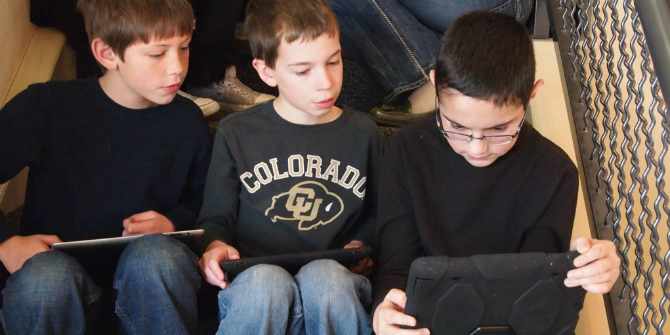Call for Regulation on Securing Children’s Data in Personalised Reading
May 26, 2017
PROJECTS: Preparing for a Digital Future
TAGS:
While children’s reading experience is being transformed with digital reading formats, personalised and interactive books allowing for more personalisation, there are risks around the data this releases. Natalia Kucirkova and Rosie Flewitt identify four main areas of concern and call for regulation. Natalia is Senior Research Associate, and Rosie is Reader in Early Communication and Learning, both at University College London, Institute of Education.

Image credit: B. Flickinger, CC BY 2.0_08
Digital reading formats mean a child’s reading experience can be ‘personalised’ at many levels. Their name can be added into a popular fairy tale, or they can even add their own drawings to a story, make their own voice-overs or replace the main characters’ names with their own (e.g. Mr Glue Stories). Personalised books are now available as interactive digital books downloadable on touchscreens (e.g. Put Me In The Story®) as well as classic printed books (e.g. Lost My Name). This can make reading more enjoyable for young children, and the personalised data that is generated can be used to create adaptive algorithms to match texts to each child’s reading level, language scores or genre preferences (see the iRead project).
Key concerns
On 16 March 2017 we hosted a meeting with some of the UK’s key players in the children’s app and print publishing industry, international researchers and representatives from Book Trust and National Literacy Trust. There was a strong consensus that there is an ‘urgent need for policy recommendations and regulations concerning children’s personalised (reading) products’.
Four key areas of concern were identified.
Risk to security and privacy
Parents are often unaware of the security risks of popular educational products, including behaviour management tools for classrooms and the ‘Internet of Toys’. These include: lack of personal safety; non-transparent and illegal terms and conditions; lack of control over access to personal data; and making this kind of surveillance seem a ‘normal’ part of everyday life.
There are no official national guidelines regarding the amount, storage or sharing of data collected by publishers and producers of personalised books, so parents and other caregivers must trust the integrity of individual companies that their family data won’t be misused or misplaced.
One designer remarked, in conversation with a producer of personalised books:
‘Because talking to you I have to trust that in a way you are using the company’s own ethical standards to do it rather than anything external. Which does raise the risk.’
‘Marketisation’ of childhood
The interviewees were not so concerned about the risks of childhood being ‘commercialised’ by simple personalisation models, but by how children’s data is aggregated:
‘It’s not about your photos but patterns of behaviour that predict what you will buy.’
Another designer-parent, commented:
‘It’s not inconceivable that a family’s aggregated data could be shared and could personalise the experience for the consumer, little consumer, the child.’
Reduction in design innovation
The lack of formal regulation and guidance also hampers the work of publishers and producers who are interested in the creative and innovative design of children’s reading products, but do not want to put children at risk:
‘There is a lot of stuff that we will not be able to do because it has that fear level to it. It kills it straight out. So I think when it comes to various aspects of data and how the data can be used I certainly think some comprehensive regulation and thinking around that and extending beyond what COPPA does and keeping it more comprehensive.’
Reduction in learning benefits for the child
The data captured through children’s book usage could be used to coordinate their choices with suggested further reading, which may then contribute to stronger learning benefits for the children. As one app designer admitted, however, the potential of this data for enhancing learning has not yet been explained:
‘I think it’s an interesting point because we could be using the data more effectively to see what they are enjoying, what they are not enjoying.’
A need for well-informed regulation
In sum, researchers, parents and the producers and publishers of personalised books and reading materials lament the lack of formal regulation. We need:
‘… regulations around the security around data as well and what can be captured and if you are capturing data how is it then stored, so that we make sure that everything that is personalised is stored very securely.’
As one app producer commented:
‘If I’m gathering a lot of data from my children at home and that can be shared with school in a way that helps my children in their formal learning environment that’s fantastic, I would like to do that, I would like to know how it’s done in a secure way.’
Some progress is being made, and the General Data Protection Regulation will apply throughout the EU (including the UK) from 25 May 2018. This may, however, need to be accompanied by a directive or list of required safety measures specific to personalised reading resources, including examples (perhaps from other sectors or areas) where personal data is being used in secure and sophisticated ways.
Developing a visionary and not simply restrictive and prohibitive guidance should mean increased collaboration and communication among a range of stakeholders.
NOTE
This article originally appeared on lse.ac.uk. It has been re-posted with permission.

